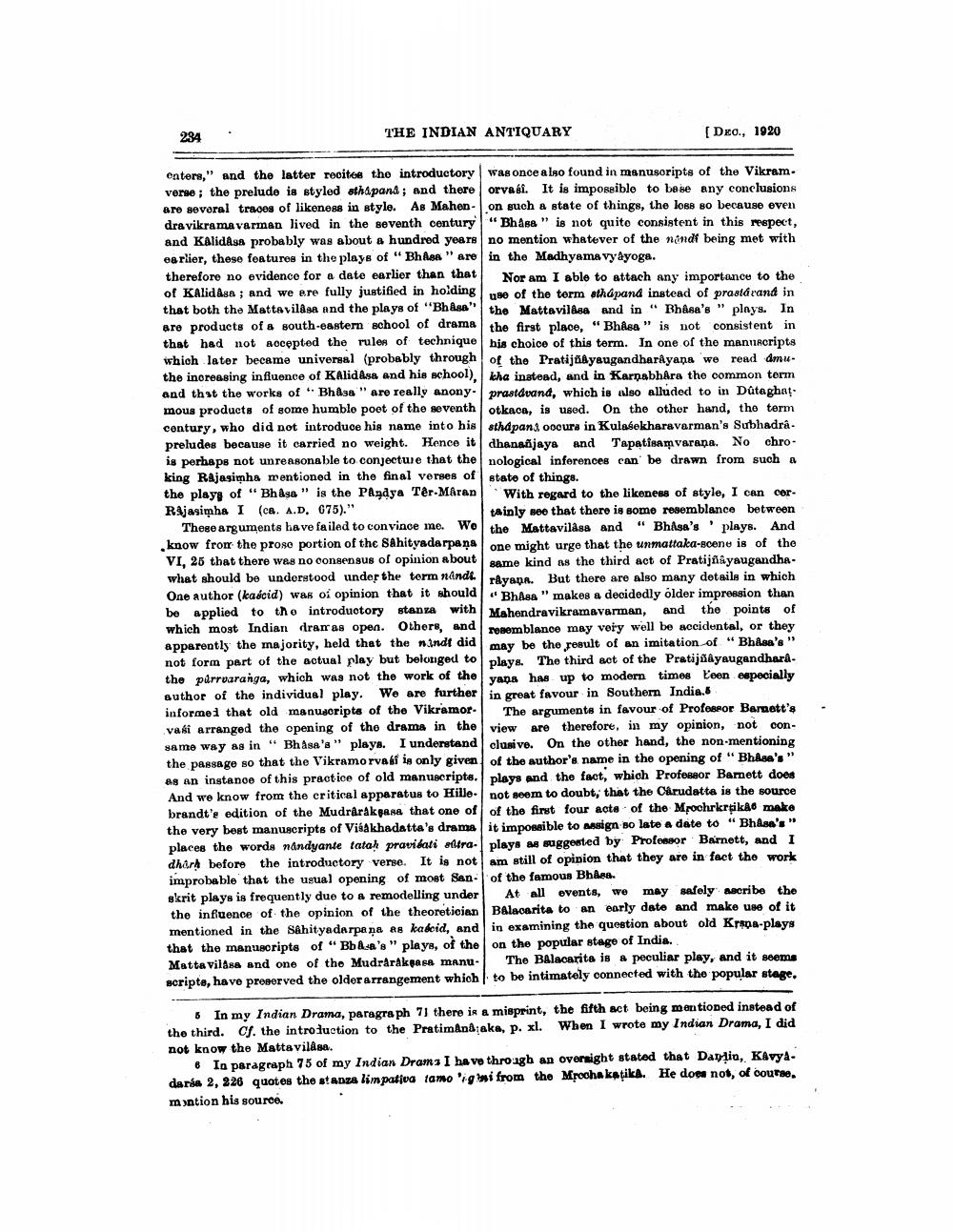________________
234
THE INDIAN ANTIQUARY
[DEO., 1920
enters," and the latter recites the introductory was once also found in manuscripts of the Vikramverse; the prelude is styled sthapana; and there orvasi. It is impossible to base any conclusions are several traces of likeness in style. As Mahen-on such a state of things, the loss so because even dravikrama varman lived in the seventh century" Bhasa" is not quite consistent in this respect, and Kalidasa probably was about a hundred years no mention whatever of the nandf being met with earlier, these features in the plays of "Bhasa" are in the Madhyama vyayoga. therefore no evidence for a date earlier than that of Kalidasa; and we are fully justified in holding that both the Mattavilåsa and the plays of "Bhasa" are products of a south-eastern school of drama that had not accepted the rules of technique which later became universal (probably through the increasing influence of Kalidasa and his school), and that the works of Bhasa" are really anonymous products of some humble poet of the seventh century, who did not introduce his name into his preludes because it carried no weight. Hence it is perhaps not unreasonable to conjecture that the king Rajasimha mentioned in the final verses of the plays of "Bhasa" is the Pandya Têr-Maran Rajasimha I (ca. A.D. 675)."
These arguments have failed to convince me. We know from the prose portion of the Sahityadarpana VI, 25 that there was no consensus of opinion about what should be understood under the term nandi One author (kascid) was of opinion that it should be applied to the introductory stanza with which most Indian dramas open. Others, and apparently the majority, held that the nindt did not form part of the actual play but belonged to the parrearanga, which was not the work of the author of the individual play. We are further informed that old manuscripts of the Vikramorvasi arranged the opening of the drama in the same way as in " Bhasa's" plays. I understand the passage so that the Vikramo rvasi is only given as an instance of this practice of old manuscripts. And we know from the critical apparatus to Hillebrandt's edition of the Mudrârâksasa that one of the very best manuscripts of Visakhadatta's drama places the words nandyante tataḥ praviéati stradhark before the introductory verse. It is not improbable that the usual opening of most Sanskrit plays is frequently due to a remodelling under the influence of the opinion of the theoretician mentioned in the Sahityadarpana as kascid, and that the manuscripts of "Bba's" plays, of the Matta vilasa and one of the Mudraraksasa manuscripts, have preserved the older arrangement which
Nor am I able to attach any importance to the use of the term sthapana instead of prastávaná in the Mattavilåsa and in" Bhasa's " plays. In the first place, "Bhasa" is not consistent in his choice of this term. In one of the manuscripts of the Pratijaâyaugandharayana we read amukha instead, and in Karnabhara the common term prastávand, which is also alluded to in Dûtaghat. otkaca, is used. On the other hand, the term sthdpans occurs in Kulasekharavarman's Subhadra. dhananjaya and Tapatisamvarana. No chronological inferences can be drawn from such a state of things.
With regard to the likeness of style, I can certainly see that there is some resemblance between the Mattavilåsa and "Bhasa's plays. And one might urge that the unmattaka-scene is of the same kind as the third act of Pratijñāyaugandharayana. But there are also many details in which Bhasa " makes a decidedly older impression than Mahendravikramavarman, and the points of resemblance may very well be accidental, or they may be the result of an imitation of "Bhasa's " plays. The third act of the Pratijñâyaugandharâ. yana has up to modern times teen especially in great favour in Southern India.
The arguments in favour of Professor Barnett's view are therefore, in my opinion, not conclusive. On the other hand, the non-mentioning of the author's name in the opening of "Bhasa's " plays and the fact, which Professor Barnett does not seem to doubt, that the Cârudatta is the source of the first four acts of the Mrochrkrțika make it impossible to assign so late a date to "Bhasa's " plays as suggested by Professor Barnett, and I am still of opinion that they are in fact the work of the famous Bhasa.
At all events, we may safely ascribe the Balacarita to an early date and make use of it in examining the question about old Krana-plays on the popular stage of India.
The Balacarita is a peculiar play, and it seems to be intimately connected with the popular stage.
5 In my Indian Drama, paragraph 71 there is a misprint, the fifth act being mentioned instead of the third. Cf. the introduction to the Pratimânâ:aka, p. xl. When I wrote my Indian Drama, I did
not know the Mattavilasa.
6 In paragraph 75 of my Indian Drama I have through an oversight stated that Daplin, Kavyadaria 2, 226 quotes the stanza limpativa tamo igni from the Mrocha katika. He does not, of course, mention his source.




